The Legend of Halong Bay: Discover Myths Behind The Names
Halong bay is known for its impressive natural beauty, and although it was recently crowned one of the new Seven Natural Wonders of the world, not many people know about the legend of the bay’s origins.
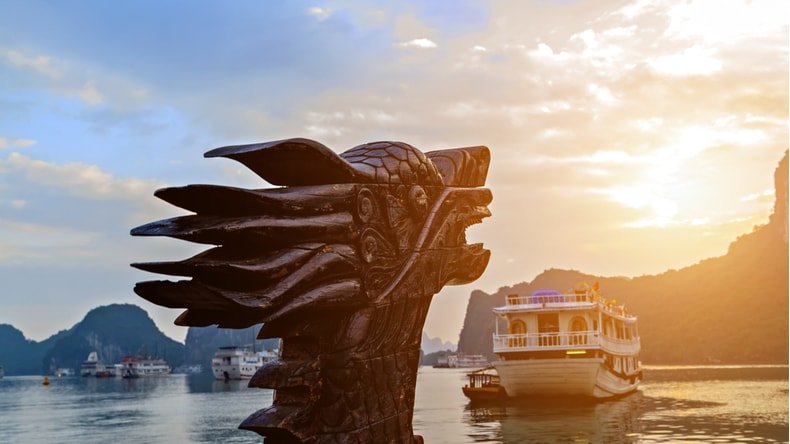
- The name "Halong" means "descending dragon" in Vietnamese, and the bay is steeped in legend and folklore.
- The legend is also a part of the general belief that Vietnamese people have Dragon's origins.
The Origin of the Name
In Vietnamese, the name “Hạ Long” translates to "descending dragon." According to ancient mythology, the Vietnamese people are believed to have descended from dragons, making the legend of Halong Bay particularly captivating.
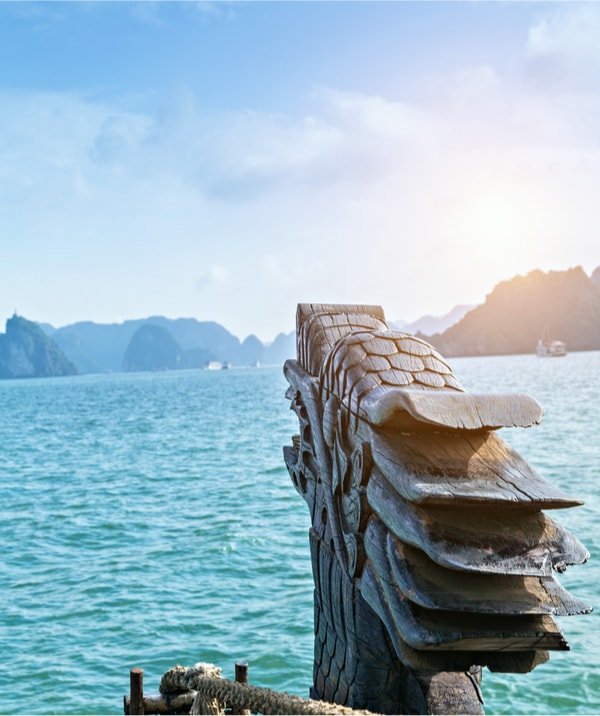 A wooden dragon head, a spiritual symbol commonly found on Halong Bay junk boats.
A wooden dragon head, a spiritual symbol commonly found on Halong Bay junk boats.
The Legend of Ha Long
Legend has it that shortly after the establishment of Vietnam, its people were compelled to defend against hostile invaders who sought to enter the nation through the sea. To safeguard his people from defeat, the esteemed Jade Emperor summoned the deities to send forth the Mother Dragon and her offspring to assist the Vietnamese in overcoming their adversaries.
The Mother Dragon and her children swiftly responded to the Emperor’s summons, coming down fiercely to confront the attackers. Despite the formidable strength of the invaders, the dragons unleashed a torrent of fire, defeating them decisively.
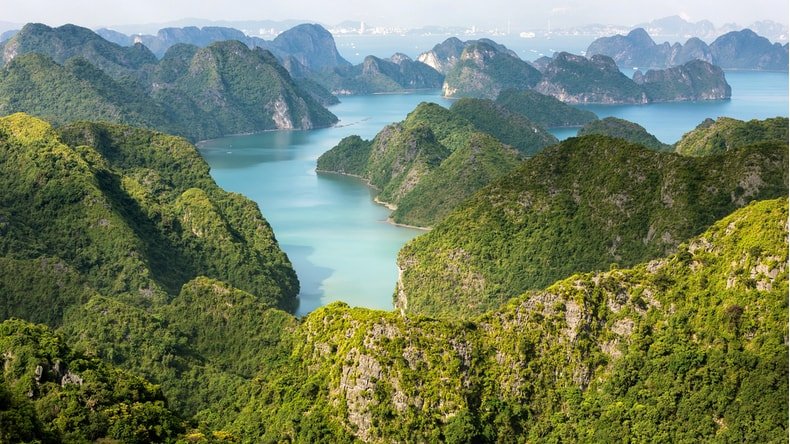 Thousands of limestone islands in Halong Bay today!
Thousands of limestone islands in Halong Bay today!
As the enemy was vanquished, giant emeralds emerged and scattered across the bay. According to the legend, these emeralds were the teeth of the Mother Dragon and her offspring. They were left behind to form an impenetrable barrier, deterring any future invasions. With peace restored in the land, over the course of a millennium, these emeralds transformed into the islands and islets that continue to captivate visitors to Halong Bay today.
Following their victory in Halong Bay, the Mother Dragon and her children did not return to their celestial abode. Instead, they chose to inhabit human forms to assist the Vietnamese people in agriculture, animal husbandry, land reclamation, and overall prosperity.
In honor of the Mother Dragon and her children’s intervention, the Vietnamese named the bay "Hạ Long," meaning "Descending Dragon," and designated the area where her children landed as "Bái Tử Long," which translates to "Respectful Bow to the Dragon's Children."
The Legend of Dau Go Cave
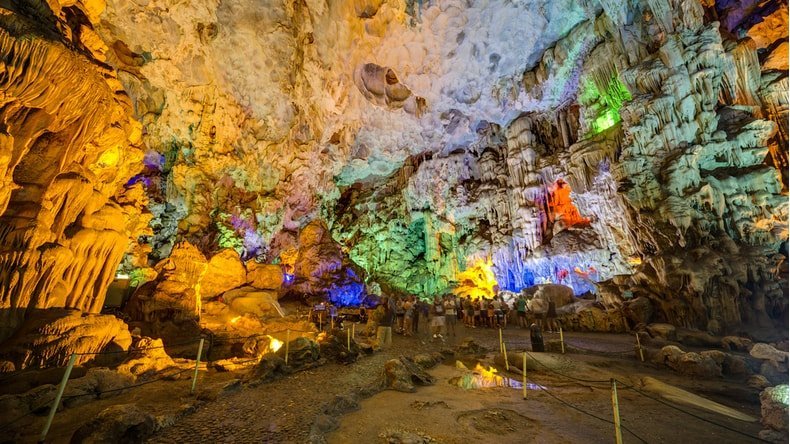
Dau Go is a large cave featuring an impressive entrance that measures 17 meters in width and 12 meters in height. Located 27 meters above sea level, it was formed during the Pleistocene era approximately 2 million years ago. The cave has remarkably preserved its ancient beauty, making it a unique geological site that remains relatively untouched by modern developments.
The name Dau Go translates to 'Wooden Head', and there are three different legends regarding its origin.
- The first tale is historical. During the conflict against the Nguyen invaders in the 13th century, soldiers from the Tran Dynasty strategically placed wooden stakes in the Bach Dang River (Yen Hung) as a trap to ambush their enemies. Due to the 'wooden heads' of these stakes, the cave came to be known as Dau Go in honor of their victory.
- The final narrative is quite straightforward. Observers claim that, from a distance, the cave resembles a giant wooden tree, prompting locals to affectionately call it 'Wooden Head' Cave.
Further reading: A guide to Dau Go cave
The Legend of Trinh Nu Cave

The legend of Trinh Nu (Virgin) Cave is a poignant tale of love and sacrifice. This enchanting cave is nestled on Bo Hon Island, which is also home to the renowned Sung Sot (Surprise) Cave.
The story is set in a time when a beautiful fisherman's daughter lived in a humble household. One fateful day, a wealthy man, captivated by her beauty, offered her a marriage proposal. However, the girl was deeply in love with another fisherman to whom she was already engaged, prompting her to reject the wealthy man's advances. Furious at her refusal, he condemned her and her family to a desolate island.
Desperate to reach her, he attempted to speak her name, but the raging wind carried away his words. In a frantic effort to gain her attention, he struck rocks against the cliffs, yet his pleas went unanswered. Exhausted from his efforts, he too eventually turned to stone.
The place where the girl transformed into stone is now recognized as Trinh Nu Cave. Today, visitors can see a natural statue of her at the entrance of the cave, alongside the statue of the petrified man gazing towards the cave. In honor of their unfulfilled love, the locals aptly named the cave ‘Trinh Nu’ or ‘Virgin’.
The Legend of Hanh Cave
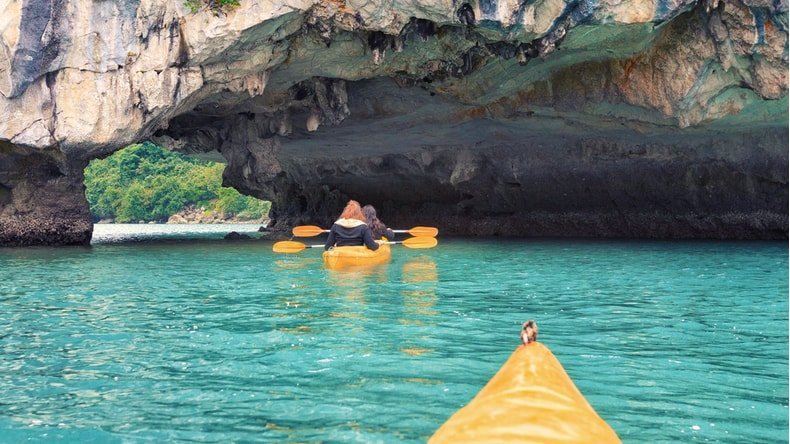
Hanh Cave is recognized as the longest cave in Halong Bay, an area renowned for its stunning natural beauty and intricate cave systems. While the cave's name is not associated with a specific legend, it carries a poignant and tragic tale. According to local lore, three enchanting young women once ventured into the cave on a boat.
Captivated by the cave's breathtaking beauty, they lost track of time and failed to notice the rising tide. Unfortunately, they were unable to escape in time and tragically drowned. In memory of these three young women, local fishermen constructed a temple dedicated to their honor.
This small temple, known as 'Ba Co' or "Three Girls," continues to stand today as a tribute to their memory, serving as a reminder of the cave's beauty and the stories woven into its history.
The Legend of Cat Ba island
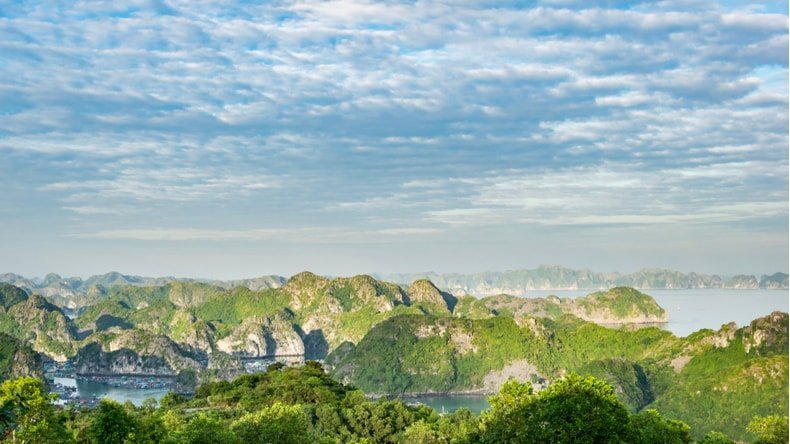
Cat Ba remains the largest island in Ha Long Bay as of 2025. Its original name, ‘Các Bà’, translates to ‘Women’ in English. Local folklore provides a fascinating backstory for this name. According to the legend, in ancient times, the women of the island were tasked with managing homes, logistics, and transportation while the men went off to battle to defend their territory. During that period, the island was affectionately known as ‘Các Bà’, or ‘Women’ island, signifying the vital role women played in sustaining the island community in times of conflict.
Conclusion
These legends have been transmitted through generations, becoming an integral part of the culture and history of the region. This makes Halong Bay not just a remarkable natural wonder, but also a cherished cultural heritage site.













